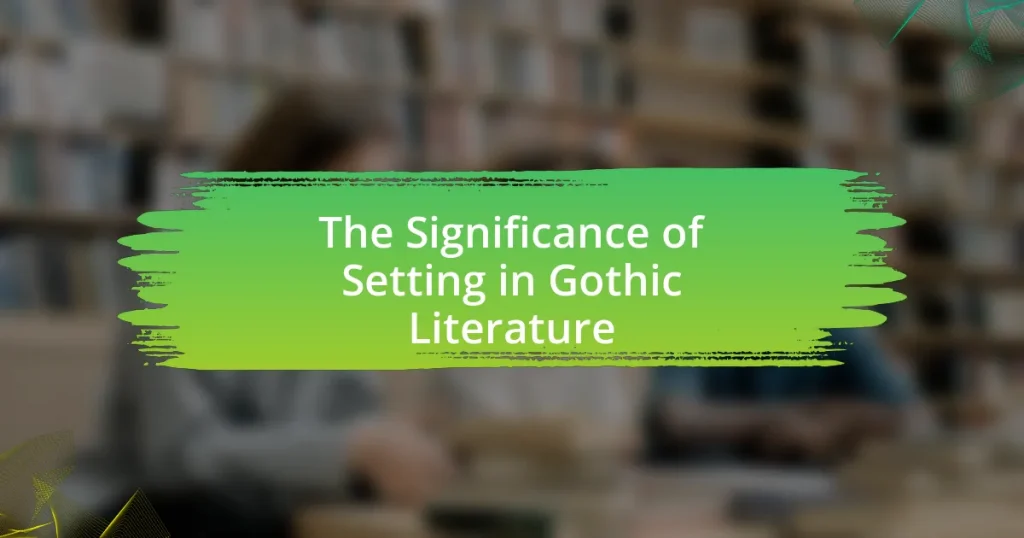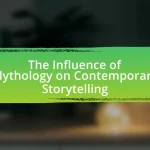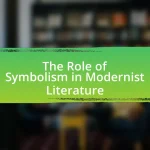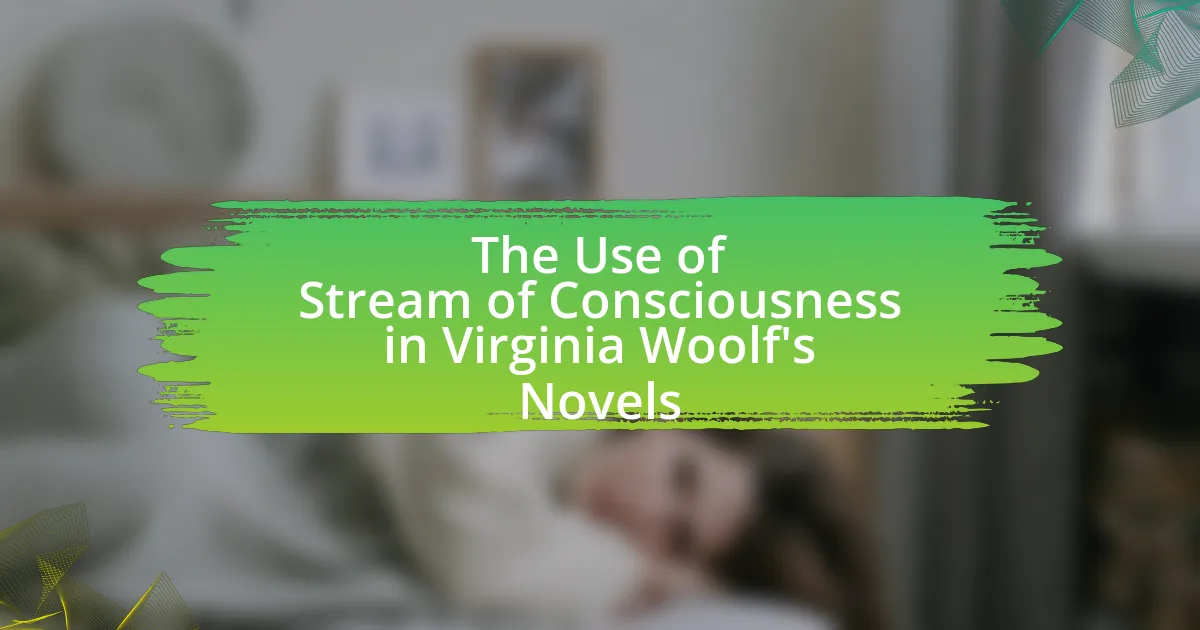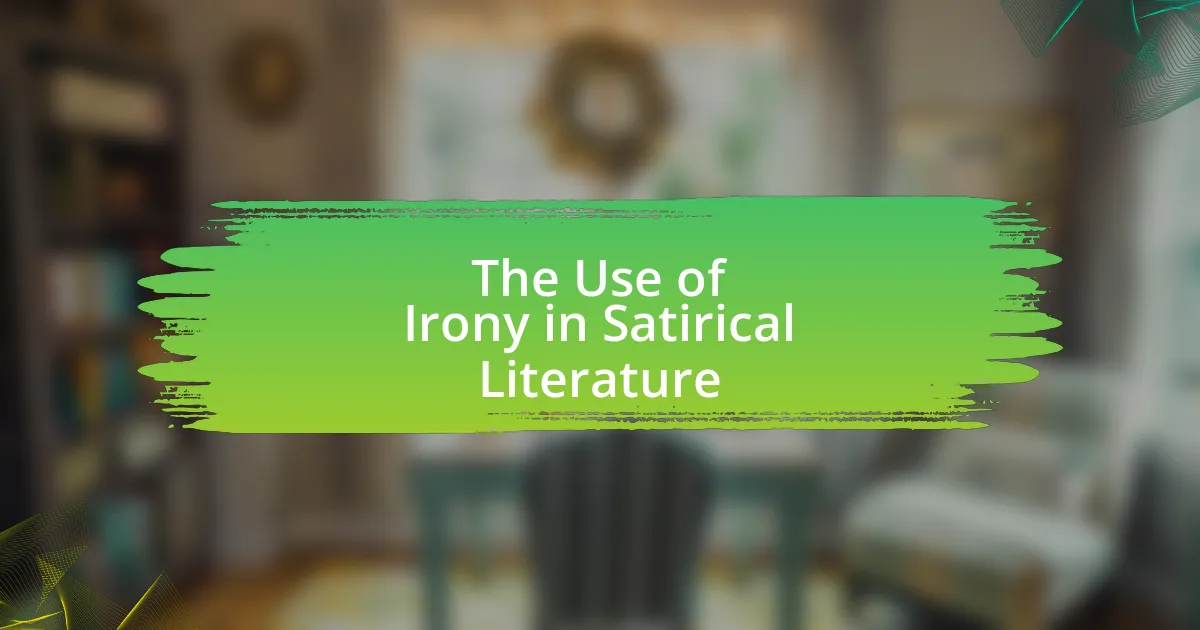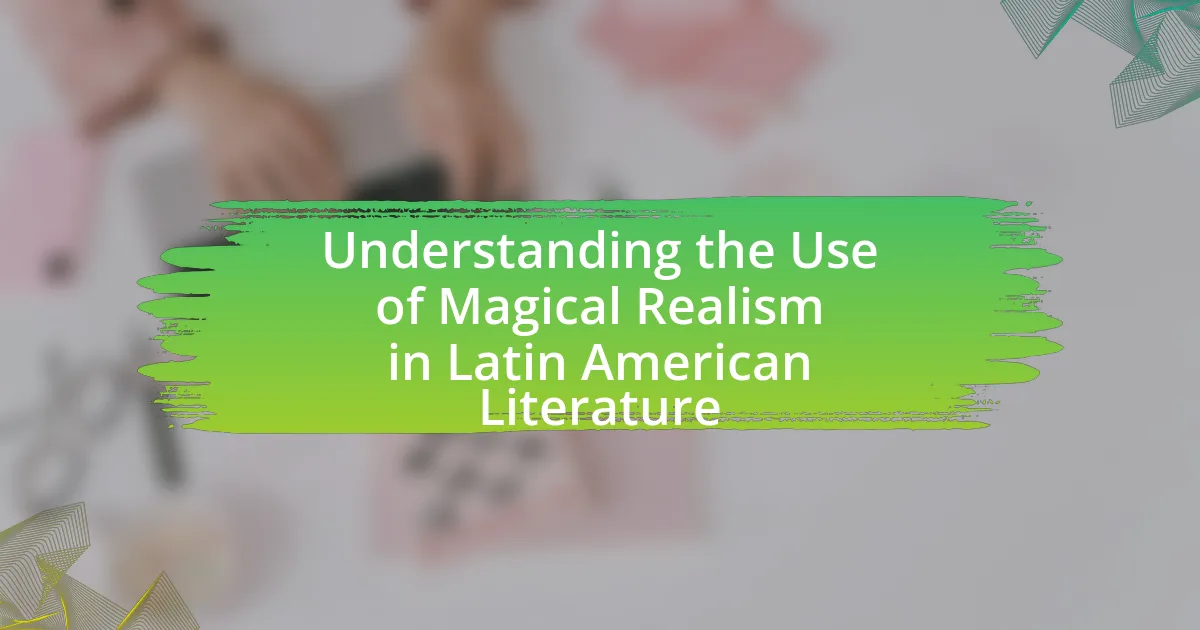The article examines the significance of setting in Gothic literature, highlighting its role in creating an atmosphere of mystery, horror, and the supernatural. It discusses how settings, such as decaying castles and isolated landscapes, reflect the psychological states of characters and enhance themes of fear and isolation. The interplay between setting and character psychology is explored, along with the influence of historical context and societal anxieties on Gothic settings. Additionally, the article outlines techniques authors use to craft compelling Gothic environments, emphasizing the importance of descriptive language, symbolism, and sensory details in evoking emotion and tension within the narrative.

What is the significance of setting in Gothic literature?
The significance of setting in Gothic literature lies in its ability to create an atmosphere of mystery, horror, and the supernatural. The settings, often characterized by decaying castles, dark forests, and isolated landscapes, serve to reflect the psychological states of characters and enhance themes of fear and isolation. For example, in Mary Shelley’s “Frankenstein,” the desolate Arctic landscape mirrors Victor Frankenstein’s emotional turmoil and moral decay. This interplay between setting and character psychology is a hallmark of Gothic literature, reinforcing the genre’s exploration of the human psyche and societal anxieties.
How does setting influence the mood and atmosphere in Gothic literature?
Setting significantly influences the mood and atmosphere in Gothic literature by creating a backdrop that evokes feelings of dread, mystery, and suspense. The use of dark, decaying castles, eerie landscapes, and oppressive weather conditions establishes an unsettling environment that reflects the characters’ inner turmoil and heightens the emotional intensity of the narrative. For example, in Mary Shelley’s “Frankenstein,” the desolate Arctic setting amplifies the themes of isolation and despair, while the gloomy settings in Edgar Allan Poe’s works often mirror the psychological states of his characters, reinforcing the overall sense of horror and unease. Thus, the setting serves as a crucial element that shapes the reader’s emotional experience and enhances the thematic depth of Gothic literature.
What elements of setting contribute to the overall tone of Gothic works?
Elements of setting that contribute to the overall tone of Gothic works include dark, decaying architecture, isolated landscapes, and oppressive atmospheres. Dark, decaying architecture, such as castles or ruins, evokes feelings of dread and mystery, often symbolizing the past’s haunting presence. Isolated landscapes, like desolate moors or dense forests, create a sense of entrapment and vulnerability, enhancing the emotional tension. Additionally, oppressive atmospheres, characterized by stormy weather or eerie silence, amplify the sense of foreboding and unease. These elements work together to establish a tone that is quintessentially Gothic, immersing readers in a world of horror and suspense.
How do specific locations enhance the themes of isolation and dread?
Specific locations enhance the themes of isolation and dread by creating an atmosphere that amplifies feelings of abandonment and fear. For instance, desolate landscapes, such as abandoned castles or remote villages, evoke a sense of solitude that isolates characters from the outside world, intensifying their psychological turmoil. The use of dark, oppressive settings, like fog-laden moors or crumbling mansions, contributes to an overarching sense of dread, as these environments often symbolize the unknown and the lurking dangers within. Historical examples include the eerie settings in Mary Shelley’s “Frankenstein,” where the protagonist’s isolation in the Arctic amplifies his despair, and the haunted house in Shirley Jackson’s “The Haunting of Hill House,” which embodies both physical and emotional confinement. These locations serve as critical elements that reinforce the narrative’s themes, making the reader acutely aware of the characters’ emotional states through their surroundings.
Why is the setting considered a character in Gothic literature?
The setting is considered a character in Gothic literature because it plays a crucial role in shaping the mood, themes, and actions of the narrative. In Gothic works, settings such as decaying castles, dark forests, and eerie landscapes often reflect the psychological states of characters and symbolize their inner turmoil. For example, in Mary Shelley’s “Frankenstein,” the desolate Arctic landscape mirrors Victor Frankenstein’s isolation and despair, illustrating how the environment influences character development and plot progression. This interplay between setting and character enhances the overall atmosphere and emotional depth of Gothic literature, making the setting an integral part of the storytelling.
In what ways does the setting interact with the protagonists?
The setting in Gothic literature interacts with the protagonists by reflecting their internal struggles and amplifying the emotional atmosphere of the narrative. For instance, dark, decaying castles or eerie landscapes often symbolize the protagonists’ psychological turmoil, creating a sense of entrapment or foreboding. This interaction is evident in works like Mary Shelley’s “Frankenstein,” where the desolate Arctic setting mirrors Victor Frankenstein’s isolation and despair, reinforcing his internal conflict. Additionally, the oppressive environments frequently serve as catalysts for character development, pushing protagonists to confront their fears and desires, as seen in Emily Brontë’s “Wuthering Heights,” where the tumultuous moors parallel Heathcliff’s tumultuous emotions. Thus, the setting not only shapes the narrative but also profoundly influences the protagonists’ journeys.
How does the setting reflect the psychological states of characters?
The setting in Gothic literature often mirrors the psychological states of characters by creating an atmosphere that reflects their inner turmoil and emotional struggles. For instance, dark, decaying castles or desolate landscapes symbolize feelings of isolation, fear, and madness experienced by characters. In Mary Shelley’s “Frankenstein,” the bleak Arctic setting parallels Victor Frankenstein’s despair and guilt, emphasizing his mental deterioration. Similarly, in Edgar Allan Poe’s “The Fall of the House of Usher,” the crumbling mansion embodies Roderick Usher’s deteriorating mental state, illustrating how the physical environment can serve as a manifestation of psychological conditions.
What role does historical context play in the setting of Gothic literature?
Historical context significantly shapes the setting of Gothic literature by influencing themes, character motivations, and the portrayal of societal fears. For instance, the rise of industrialization in the 18th and 19th centuries led to a fascination with the supernatural and the unknown, as seen in works like Mary Shelley’s “Frankenstein,” which reflects anxieties about scientific advancement and its moral implications. Additionally, the Romantic movement, which emphasized emotion and nature, provided a backdrop for Gothic settings that often feature decaying castles and wild landscapes, symbolizing the conflict between civilization and nature. These historical elements create a rich tapestry that enhances the eerie atmosphere and psychological depth characteristic of Gothic literature.
How do societal fears and anxieties shape the settings in Gothic texts?
Societal fears and anxieties significantly shape the settings in Gothic texts by reflecting the cultural and psychological tensions of the time. For instance, during the Victorian era, fears surrounding industrialization and the loss of traditional values manifested in Gothic settings characterized by decaying mansions and eerie landscapes, symbolizing the anxiety over societal change. The use of dark, claustrophobic environments in works like Mary Shelley’s “Frankenstein” illustrates the fear of the unknown and the consequences of unchecked scientific ambition. Additionally, settings often embody themes of isolation and entrapment, mirroring societal concerns about mental health and the individual’s place within a rapidly evolving society. These elements demonstrate how Gothic literature serves as a lens through which societal fears are explored and critiqued.
What historical events influence the portrayal of settings in Gothic literature?
The portrayal of settings in Gothic literature is significantly influenced by historical events such as the Industrial Revolution, the rise of Romanticism, and the socio-political upheavals of the 18th and 19th centuries. The Industrial Revolution, which began in the late 18th century, introduced themes of alienation and decay, as urbanization transformed landscapes and created a stark contrast between nature and industrial settings. This shift is evident in works like Mary Shelley’s “Frankenstein,” where the setting reflects the anxieties of technological advancement.
Additionally, the Romantic movement, emerging in the late 18th century, emphasized emotion and the sublime, leading to the use of dark, mysterious landscapes in Gothic literature, as seen in works by authors like Edgar Allan Poe. The socio-political upheavals, including the French Revolution, also contributed to the Gothic setting by instilling a sense of fear and uncertainty, which is reflected in the chaotic and oppressive environments depicted in novels such as “The Mysteries of Udolpho” by Ann Radcliffe. These historical contexts provide a framework that shapes the eerie and often foreboding atmospheres characteristic of Gothic literature.

How do different types of settings affect Gothic narratives?
Different types of settings significantly influence Gothic narratives by establishing mood, enhancing themes, and shaping character experiences. For instance, isolated castles or decaying mansions evoke feelings of dread and entrapment, which are central to the Gothic genre. The oppressive atmosphere of these settings often reflects the psychological states of characters, such as fear or madness, as seen in works like Edgar Allan Poe’s “The Fall of the House of Usher,” where the house itself becomes a character that embodies decay and despair. Additionally, natural settings, such as dark forests or stormy landscapes, can symbolize internal conflict and chaos, reinforcing the emotional turmoil faced by protagonists. The interplay between setting and narrative elements is crucial in creating the suspense and horror that define Gothic literature.
What are the common types of settings found in Gothic literature?
Common types of settings found in Gothic literature include decaying castles, haunted mansions, and remote landscapes. These settings often evoke a sense of mystery and dread, contributing to the overall atmosphere of the narrative. For instance, decaying castles symbolize the decline of noble families and the passage of time, while haunted mansions often serve as a backdrop for supernatural occurrences and psychological tension. Remote landscapes, such as dark forests or desolate moors, enhance feelings of isolation and vulnerability, which are central themes in Gothic works. Notable examples include the castle in Mary Shelley’s “Frankenstein” and the eerie mansion in Edgar Allan Poe’s “The Fall of the House of Usher,” both of which exemplify how these settings amplify the emotional and thematic depth of the stories.
How do castles and mansions serve as quintessential Gothic settings?
Castles and mansions serve as quintessential Gothic settings by embodying elements of mystery, decay, and the supernatural. These structures often feature imposing architecture, dark corridors, and hidden chambers, which create an atmosphere of suspense and foreboding. For instance, the use of castles in Gothic literature, such as in Bram Stoker’s “Dracula,” highlights themes of isolation and entrapment, as the characters navigate the labyrinthine spaces that evoke fear and intrigue. Additionally, the historical associations of these buildings with aristocracy and past glories contribute to a sense of haunting, as they often symbolize the remnants of a bygone era. This interplay of grandeur and decay reinforces the emotional and psychological tension central to Gothic narratives.
What role do natural landscapes play in creating Gothic atmospheres?
Natural landscapes play a crucial role in creating Gothic atmospheres by enhancing feelings of isolation, dread, and the sublime. The depiction of wild, untamed nature, such as dark forests, craggy mountains, and desolate moors, evokes a sense of the unknown and the supernatural, which are central to Gothic literature. For instance, in Mary Shelley’s “Frankenstein,” the bleak Arctic landscape mirrors Victor Frankenstein’s inner turmoil and the monstrous consequences of his ambition. Similarly, the moors in Emily Brontë’s “Wuthering Heights” serve as a backdrop for the tumultuous emotions and chaotic relationships of the characters, reinforcing themes of passion and despair. These landscapes not only set the physical stage but also symbolize the psychological states of characters, thereby deepening the overall Gothic atmosphere.
How does urban versus rural setting impact Gothic storytelling?
Urban settings in Gothic storytelling often amplify themes of isolation, anxiety, and the uncanny due to their dense populations and industrial landscapes, while rural settings evoke a sense of timelessness, nature’s unpredictability, and the supernatural. Urban environments, characterized by their chaotic and impersonal nature, create a backdrop for psychological horror, as seen in works like “The Strange Case of Dr Jekyll and Mr Hyde” by Robert Louis Stevenson, where the city reflects the duality of human nature. Conversely, rural settings, exemplified in stories like “The Haunting of Hill House” by Shirley Jackson, often emphasize isolation and the unknown, allowing for exploration of folklore and ancestral fears. The contrast between these settings shapes the narrative’s mood, character development, and thematic depth, illustrating how environment influences the Gothic genre’s exploration of human fears and societal issues.
What unique challenges do characters face in urban Gothic settings?
Characters in urban Gothic settings face the unique challenges of isolation, alienation, and the pervasive influence of urban decay. The dense, often oppressive atmosphere of the city can amplify feelings of loneliness, as individuals navigate through crowds yet feel disconnected from others. This sense of alienation is heightened by the juxtaposition of modernity and the remnants of historical darkness, creating a backdrop where characters confront both personal and societal demons. Urban decay, characterized by crumbling buildings and neglected spaces, serves as a physical manifestation of the characters’ internal struggles, reflecting their fears and anxieties. These elements combine to create a complex environment where characters must grapple with their identities and the moral ambiguities of urban life, often leading to psychological turmoil and existential crises.
How does the rural setting contribute to themes of mystery and the supernatural?
The rural setting enhances themes of mystery and the supernatural by creating an isolated and often eerie atmosphere that fosters suspense and intrigue. In Gothic literature, rural landscapes are frequently depicted as remote and desolate, which amplifies feelings of vulnerability and fear. For instance, the use of fog, dense forests, and abandoned structures in works like Emily Brontë’s “Wuthering Heights” contributes to an unsettling environment where supernatural occurrences can thrive. This isolation allows for the exploration of hidden secrets and the unknown, as characters often confront both external and internal fears in these secluded spaces. The juxtaposition of nature’s beauty with its potential for danger further deepens the sense of mystery, making the rural setting a crucial element in the development of supernatural themes.

What techniques do authors use to create effective Gothic settings?
Authors create effective Gothic settings through techniques such as vivid imagery, atmospheric descriptions, and the use of architectural elements. Vivid imagery evokes strong sensory experiences, allowing readers to visualize dark, foreboding landscapes or decaying mansions, which are common in Gothic literature. Atmospheric descriptions enhance the mood, often incorporating elements like fog, shadows, and eerie sounds to instill a sense of dread. Architectural elements, such as castles or ruins, serve as physical manifestations of the themes of isolation and entrapment, reinforcing the emotional states of characters. These techniques collectively immerse readers in a haunting environment, essential for the Gothic genre.
How do descriptive language and imagery enhance the setting in Gothic literature?
Descriptive language and imagery significantly enhance the setting in Gothic literature by creating an atmosphere of mystery and dread. This literary technique immerses readers in dark, foreboding environments, often characterized by decaying castles, eerie landscapes, and oppressive weather. For instance, authors like Edgar Allan Poe and Mary Shelley utilize vivid descriptions to evoke feelings of unease and suspense, effectively drawing readers into the emotional landscape of the characters. The use of sensory details, such as the chilling sounds of the wind or the oppressive darkness, reinforces the themes of isolation and terror that are central to Gothic narratives. Such imagery not only establishes the physical setting but also reflects the psychological states of characters, thereby deepening the overall impact of the story.
What specific literary devices are commonly used to evoke a Gothic atmosphere?
Common literary devices used to evoke a Gothic atmosphere include imagery, symbolism, and foreshadowing. Imagery creates vivid descriptions of dark, eerie settings, such as decaying castles or fog-laden landscapes, which immerse readers in a haunting environment. Symbolism often employs objects or elements, like the use of shadows or storms, to represent underlying themes of fear and the supernatural. Foreshadowing builds suspense by hinting at future events, creating an ominous tone that heightens the sense of dread. These devices collectively enhance the emotional impact and thematic depth characteristic of Gothic literature.
How does foreshadowing through setting contribute to narrative tension?
Foreshadowing through setting significantly contributes to narrative tension by creating an atmosphere that hints at future events, thereby heightening the reader’s anticipation and anxiety. In Gothic literature, settings often include dark, decaying castles or ominous landscapes that evoke feelings of dread and foreboding. For example, in Mary Shelley’s “Frankenstein,” the desolate Arctic setting foreshadows the tragic consequences of Victor Frankenstein’s ambition, amplifying the tension as readers sense impending doom. This use of setting not only establishes mood but also serves as a narrative device that signals danger, compelling readers to engage more deeply with the unfolding story.
What role does symbolism play in the setting of Gothic works?
Symbolism plays a crucial role in the setting of Gothic works by enhancing the atmosphere and reflecting the emotional states of characters. In Gothic literature, settings such as decaying castles, dark forests, and eerie landscapes symbolize themes of isolation, fear, and the supernatural. For instance, the crumbling architecture often represents the decline of moral values or the past’s haunting presence, as seen in works like Mary Shelley’s “Frankenstein,” where the desolate settings mirror the protagonist’s inner turmoil. This use of symbolism not only deepens the reader’s understanding of the characters’ psychological struggles but also reinforces the overarching themes of dread and the uncanny that are central to the Gothic genre.
How do specific symbols within the setting deepen the reader’s understanding of themes?
Specific symbols within the setting enhance the reader’s understanding of themes by providing visual and contextual cues that reflect underlying messages. For instance, in Gothic literature, decaying castles often symbolize the decline of nobility and the passage of time, reinforcing themes of decay and mortality. The presence of stormy weather can signify turmoil or emotional unrest, deepening the exploration of psychological themes such as madness or despair. These symbols serve as tangible representations of abstract concepts, allowing readers to connect emotionally and intellectually with the narrative’s themes.
What are some examples of symbolic settings in notable Gothic literature?
Examples of symbolic settings in notable Gothic literature include the decaying castles in “The Castle of Otranto” by Horace Walpole, which represent the decline of aristocracy and the supernatural. Another example is the moors in “Wuthering Heights” by Emily Brontë, symbolizing the tumultuous emotions and wild nature of the characters. Additionally, the isolated mansion in “The Fall of the House of Usher” by Edgar Allan Poe serves as a reflection of the mental deterioration of its inhabitants. These settings are integral to the themes of decay, isolation, and the supernatural prevalent in Gothic literature.
What practical tips can writers use to craft compelling Gothic settings?
Writers can craft compelling Gothic settings by focusing on atmospheric details, incorporating elements of decay, and utilizing isolation. Atmospheric details, such as dim lighting, eerie sounds, and unsettling weather, create a mood that enhances the Gothic experience. Incorporating elements of decay, like crumbling architecture or overgrown landscapes, evokes a sense of history and neglect, which is central to Gothic themes. Isolation, whether physical or emotional, amplifies tension and creates a sense of vulnerability, often seen in classic Gothic works like Mary Shelley’s “Frankenstein” and Bram Stoker’s “Dracula,” where settings play a crucial role in character development and plot progression.
How can writers effectively research historical settings for authenticity?
Writers can effectively research historical settings for authenticity by utilizing primary sources, such as letters, diaries, and newspapers from the period, alongside secondary sources like historical analyses and academic journals. Primary sources provide firsthand accounts and details that reflect the social, cultural, and political climate of the time, while secondary sources offer context and interpretation of those events. For example, the use of the “British Newspaper Archive” allows writers to access articles from the 19th century, providing insights into public sentiment and daily life during that era. Additionally, visiting historical sites and museums can enhance understanding through direct observation of artifacts and architecture relevant to the setting. This combination of resources ensures that the portrayal of historical settings is grounded in factual accuracy and rich detail, contributing to the overall authenticity in Gothic literature.
What strategies can be employed to evoke emotion through setting descriptions?
To evoke emotion through setting descriptions, writers can employ strategies such as sensory detail, mood establishment, and symbolic elements. Sensory detail engages readers by appealing to sight, sound, smell, touch, and taste, creating a vivid and immersive experience. For instance, describing a decaying mansion with musty odors and creaking floorboards can evoke feelings of dread and nostalgia. Mood establishment involves using language that reflects the emotional tone of the setting, such as dark, stormy weather to create tension or a serene landscape to evoke peace. Symbolic elements, like a withered tree representing despair, can deepen emotional resonance by linking the setting to character experiences or themes. These strategies are effective in Gothic literature, where atmosphere plays a crucial role in shaping reader emotions and enhancing the narrative’s impact.
